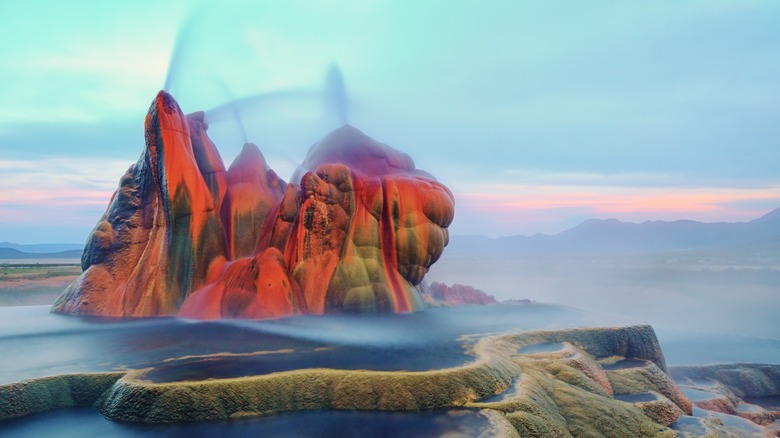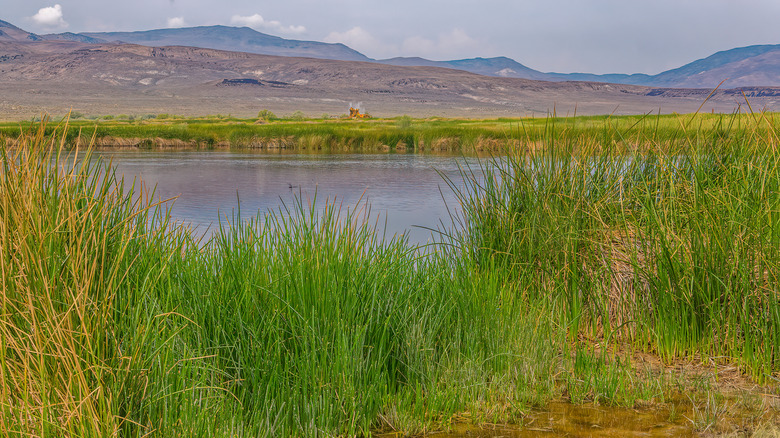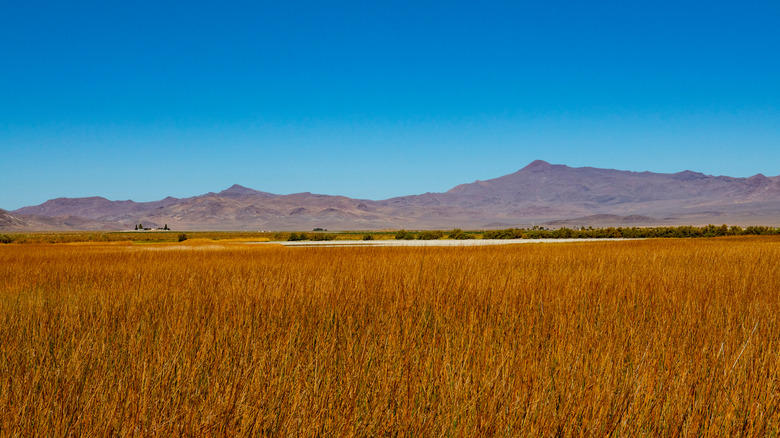Situated Off Route 34 In Nevada Is An Underrated Geyser Displaying Nature's Artwork
Nevada's vast plains showcase diverse landscapes, from the jagged red stone formations at Valley of Fire State Park to the stunning waters of the iconic Lake Tahoe. Driving along State Route 34 in northern Nevada, near the otherworldly terrain of the Black Rock Desert, feels worlds apart from Las Vegas' 4-mile-long strip of glittering lights and flamboyant architecture. While the Black Rock Desert is best known for hosting the Burning Man Festival and for being the site where the land-speed record was broken back in the 1990s, it also holds significant geological importance that few people know about. Among its unique features is the Fly Ranch Geyser, located at Fly Ranch, a 30-minute drive north of Gerlach, a town with a rapidly declining population of just six people recorded in 2024.
The geyser was not always as prominent as it is now, climbing six feet into the air and spewing hot water even further, visible from miles away. Interestingly, this natural formation resulted from unnatural means. The geothermal spring was discovered over 100 years ago when the land was drilled for the purpose of building a well. This project was abandoned when it was discovered that the water was too hot for its intended agricultural use, with temperatures reaching nearly 200 degrees Fahrenheit. Further attempts to harness the geothermal energy in the 1960s also fell through, however this time the disruption to the land prompted the formation of the geysers we see today.
Uncovering the geological significance of the Fly Ranch Geyser
The Black Rock Desert is the site of a prehistoric seabed called Lake Lahontan, and Nevada is no stranger to geothermal energy sources. Recent discoveries of geothermal well potential in surrounding Hualapai Geothermal Flats in the state have prompted new possibilities for harnessing renewable energy. The geyser's formation is due to mineral deposits that have collected over decades, while thermophilic algae thriving and growing in the moist, warm conditions give it its unique rainbow color. Geysers are notoriously rare, with an estimated 1,000 known sites scattered throughout the world, making this a particularly special phenomenon.
There are a total of three geysers located on the 3,800-acre property, with Fly Ranch Geyser being the largest and most impressive. The site serves as an oasis for over 300 different species of plants, birds, and other types of wildlife. Ecological surveys have confirmed the presence of wild horses, pronghorn antelope, bobcats, mule deer, and coyotes in the area. The Fly Ranch Geyser is also home to the rare Fly Ranch pyrg snail, a new species to the area and unique to its habitat. This ecological diversity further emphasizes the importance of preserving the site for future generations, and money raised from visitor tours supports the Black Rock Desert-High Rock Canyon National Conservation Area.
Visiting the Fly Ranch Geyser
The multicolored geyser is found within Fly Ranch, a privately owned piece of land in Washoe County, Nevada. Because the site is located on private property, visiting the Fly Ranch Geyser can only be done through pre-arranged tours by Friends Of Black Rock High-Rock, with limited public access. Visitors can arrange a three-hour nature walk covering approximately 3 miles in small groups for $50 for adults, with free admission for children under 12 years old online here. Wearing comfortable shoes and bringing sun protection is a must. Try to arrive a little earlier than your scheduled tour to allow time for filling out forms. One Google reviewer shared, "What a spectacular experience! We learned so much about plants, animals, the history of the land and future projects they are implementing. The volunteers that guided us are some awesome people. ...The tour is well worth their ticket price. ... Unforgettable!"
The tour showcases the property, explains the history and geology behind the site, and offers information about the nearby Burning Man Festival and surrounding works of art. Interestingly, to encourage full immersion in the experience, using cameras or taking photographs of any kind is prohibited until the end of the tour. The hot springs are preserved (and very hot), so therefore, swimming is not allowed. This underrated attraction significantly impacts its surrounding landscape, supporting life in conditions that would otherwise be inhospitable. The geyser continues to grow in size, making it a fascinating, ever-changing destination to visit for years to come. Beyond the geysers, the breathtaking landscape features epic vistas of the surrounding wetlands — you might even spot wild horses roaming freely. For more adventure after, check out Reno, a walkable hub of food, art, and outdoor fun.


